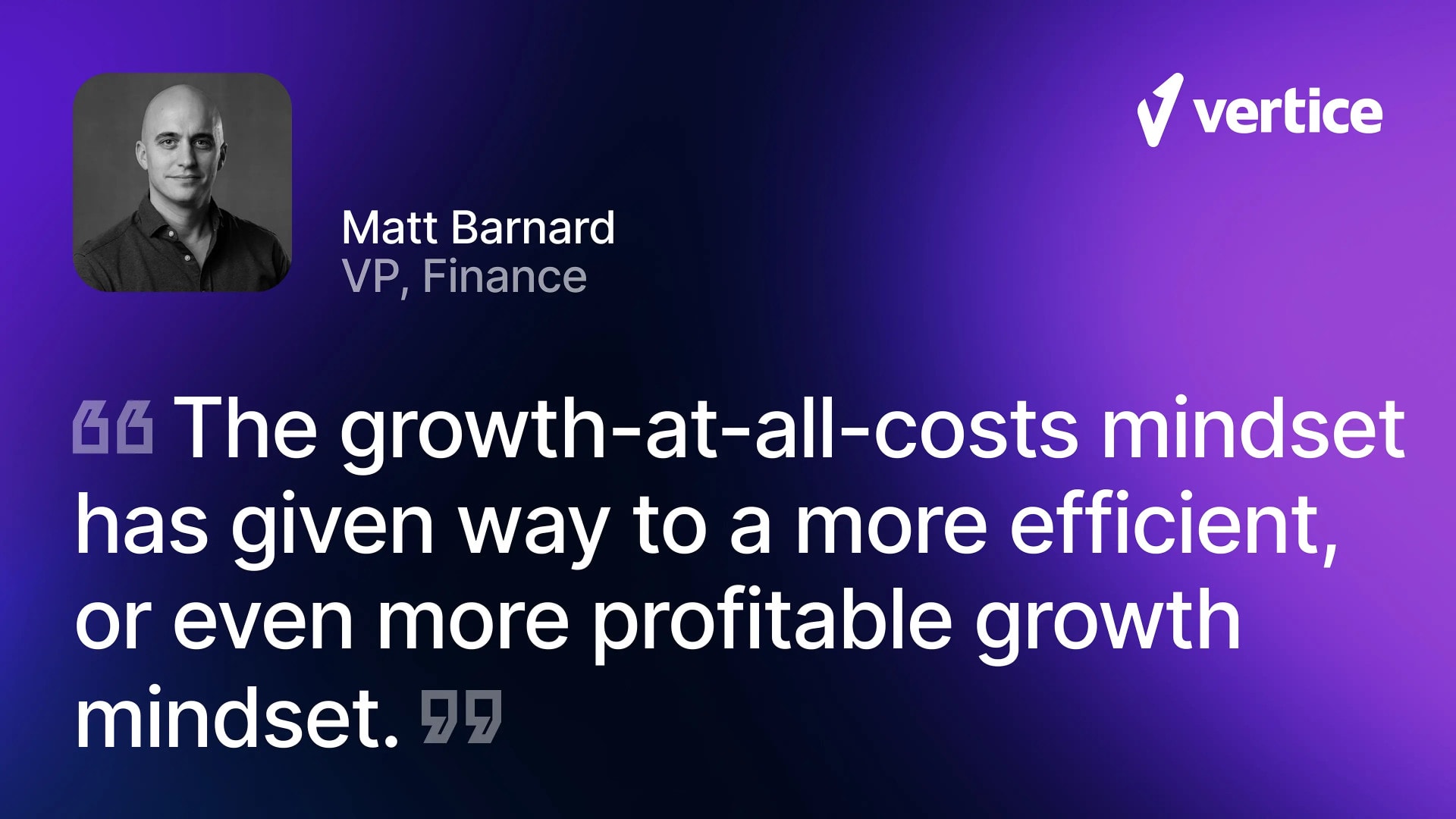For the vast majority of organizations, growth is a clear indicator of business success. The problem is, the unfavorable economic conditions of recent years have, without a doubt, transformed the way companies can achieve this growth – and more specifically, the way they can access the cash required to scale successfully.
Improving operational efficiency is, therefore, key.
The question is, how can this be achieved?
Our very own VP of Finance, Matt Barnard, recently joined Paddle’s CFO, Philip Watson, to discuss the steps that companies should take to boost their SaaS operating margins in 2024.
Here are the key takeaways from the webinar.
Shift from a ‘growth at all costs’ mindset to an efficient growth mindset
Up until a few short years ago, virtually any software company could easily raise capital. Interest rates were at an all time low, rapid advancements in technology created a sense of excitement and potential for significant returns, and investors were more willing to provide the necessary funds.
Unfortunately, those days are long gone.
The knock-on effect of countless macroeconomic events has not only put an end to what could only be described as the Wild West of SaaS spending, but it has also required many organizations to enter into survival mode.
Just take the mass layoffs we’ve been seeing across the tech industry – as of November 2023, 224,503 individuals had been made redundant.
But while reducing headcount is certainly one way to reduce expenditure, more companies are reckoning with the fact that it is not the most sustainable cost cutting option, considering the knock-on effects it can have on company reputation, the remaining workforce, and ultimately company performance.
According to Vertice’s own VP Finance, Matt Barnard, the overall effects of the economy have paved the way for more efficiency-focused growth. “The growth at all costs mindset has given way to a more efficient, or even profitable growth mindset.”

When asked for his take, Paddle’s CFO, Philip Watson, agreed that it’s more important than ever that organizations strive for operational efficiency. “In a world where it’s become more difficult and expensive to raise funds, cash flow has become all the more imperative”, he explained.
But while macro environmental impacts have undoubtedly rocked the vast majority of organizations, if statements from some of the leading SaaS companies are anything to go by, is it possible that the tide is slowly beginning to turn?
Matt believes it could be. “In recent weeks, HubSpot and ZoomInfo, two of the biggest players in SaaS, released their Q3 earnings and both CEOs had a very similar message that, while trading conditions aren’t necessarily getting any easier, they’re also not getting any worse.”
While it may be too early to say, this could indicate that we’re starting to see some very early signs that the software industry is out of the worst of it.
And it’s not just these companies that are taking a slightly more positive stance. A recent report from Deloitte also found that finance leaders are feeling mildly optimistic about the financial prospects of their organization.
Focus on the metrics that matter
Regardless of what the future may bring in terms of financial stability, it’s clear that operational efficiency is the only long-term solution for companies to achieve sustainable growth.
The question is, which metrics should finance leaders focus on?
According to Matt, the best place to start is your gross margin.
“When I think about assessing the health of a SaaS company, a pretty easy place to start with is your gross margin. This is because it’s simple, fundamental to your success and easy to benchmark. I also want to know what we are doing with customer retention and churn, so net and gross revenue retention are the gold standard here, as they are crucial to building a sustainable SaaS company.”
“Specific to growth efficiency, one metric I quite like to use is CAC ratio – how much we’re spending on sales and marketing to add $1 of ARR”, Matt continued.
He also recommended looking at your ARR per employee, as despite it being a simple metric, it very clearly quantifies your ability to do more with less. “If this is starting to plateau, it’s a clear indicator that you may have some issues with your scalability.”
Philip, however, believes that companies need to be looking deeper than just these top-level metrics.
“ARR, LTV to CAC and so on are all crucial metrics, but I would argue that you also want to focus on what’s driving those metrics. Sure, you should absolutely measure ARR, but you should also be asking how you can get incremental ARR, not just whether you have more of it”.
This means looking beyond your total ARR per company and actually ensuring that your ARR metrics per week, quarter, department, geography, channel and so on are incremental as well. For example, you could be stagnant in APAC for months, while EMEA is responsible for much of the ARR growth. Knowing and understanding laggards is key to making informed decisions.
According to Philip, there are other metrics that organizations don’t always consider, but that can be a good indication of a company’s health.
“SaaS companies should be rolling their numbers from one period to the next, as these rolls can tell you how your business is behaving.” One area in particular he recommends rolling is your deferred revenue with billing.
“This isn’t something that many finance leaders think about, but knowing how your deferred revenue is going up and down is really important and can give you insights into your business performance.”
“It’s also worth rolling your head count spend”, Philip continued to explain. “By starting with an annualized cost in one time period, we were then able to see how this area of spending had changed with people joining, leaving, receiving raises and so on. This approach ultimately enables business leaders to see where their dollars are being spent each period.”
Finally, both Matt and Philip stressed the importance of not looking at any metric in isolation.
“With any metric, context is everything”, explained Matt. “As an example, you may be willing to tolerate a higher cost of acquiring a new customer if you have best in class retention.”
Philip agreed, stating that “being able to tie all your metrics together will allow you to operate a much more efficient company”.
Quick ways to boost operational efficiency
So, what dials can you start turning to enhance operational efficiency in 2024?
Optimize your cloud spend
According to Matt, one of the most obvious ways to improve operational efficiency is by optimizing your cloud spend.
“Start by negotiating with your hosting providers and put in place spend commitments and multi-year contracts in exchange for discounts. It’s also worth looking into Reserved Instances (RIs) to optimize your unit costs.”
While cloud cost optimization won’t necessarily be something you can do as a finance leader, it is something you should partner with your tech leader on, as it does hold the key to significant cost-savings.
“Work with your tech teams to ensure that capacity planning is being properly handled and that you’re putting a cap on unnecessary usage”. With our data indicating that a third of cloud spend goes entirely to waste within the average organization and costs increasing by 4.2% each month, failing to optimize this area of spending could have catastrophic implications for your business in the years ahead.
Rationalize your software spend
With data showing that SaaS now accounts for 14.1% of total organizational spend within the average company, up from 12.7% last year, it’s clear that it’s an area of spending that finance leaders need to be looking into – especially when you consider the fact that 33% goes entirely to waste.
So, while there are clearly cost-saving opportunities that exist within the average SaaS stack, where exactly do you start?
Well, with many companies now using in excess of 130 software applications, Matt’s first suggestion was to rationalize your software usage.
“Look at instances of feature overlap within your stack and consider whether you can consolidate vendors.”
With a third of software licenses either going unused or underutilized, you should also be tracking this usage and looking for ways to reduce the number of licenses or seats you actually need. “Consider whether certain teams or individuals actually need a license to a particular platform”, explained Matt. “In many cases, they don’t.”

Finally, when it comes to purchasing new software or renegotiating your contracts, it’s imperative that you do all you can to avoid overpaying – something that impacts as many as 90% of companies.
“Question whether you’re paying a fair price for the tool by drawing on comparisons of what other customers are paying”, recommends Matt.
But with pricing transparency being a widespread issue across the industry, how can you go about obtaining this intel?
In short, with Vertice.
How to reduce your SaaS and cloud costs with Vertice
With SaaS and cloud costs now accounting for around a quarter of total spending within the average organization, very few companies have been left unscathed by soaring price hikes.
Being able to effectively identify wastage and optimize costs in both areas is fundamental to achieving operational efficiency in 2024.
Which is where Vertice comes in.
As a SaaS and Cloud Spend Optimization Platform, we not only provide you with a unified view of your spend and usage for each, providing invaluable insights and highlighting cost-saving opportunities, but with access to the transactional data for more than 16,000 global software vendors, we can also negotiate you the best possible deal for every tool within your tech stack – saving you a significant amount on your annual spend.
See for yourself how much you could be saving or alternatively, find out how Vertice identified more than $1 million in cloud savings for a leading cybersecurity company.



